Uranium (nuclear) basics
Did you know?
Nuclear power plants have supplied about 20% of annual U.S. electricity generation since 1990.
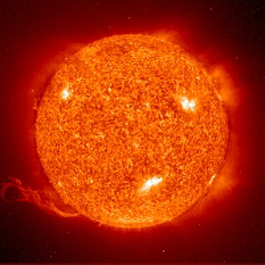
Source: NASA (public domain)

Nuclear energy is energy in the core of an atom
Atoms are the tiny particles in the molecules that make up gases, liquids, and solids. Atoms themselves are made up of three particles called protons, neutrons, and electrons. An atom has a nucleus (or core) containing protons and neutrons, which is surrounded by electrons. Protons carry a positive electrical charge and electrons carry a negative electrical charge. Neutrons do not have an electrical charge. Enormous energy is present in the bonds that hold the nucleus together. This nuclear energy can be released when those bonds are broken. The bonds can be broken through nuclear fission, and this energy can be used to produce electricity.
In nuclear fission, atoms are split apart, which releases energy. All nuclear power plants use nuclear fission, and most nuclear power plants use uranium atoms. During nuclear fission, a neutron collides with a uranium atom and splits it, releasing a large amount of energy in the form of heat and radiation. More neutrons are also released when a uranium atom splits. These neutrons continue to collide with other uranium atoms, and the process repeats itself over and over again. This process is called a nuclear chain reaction. This reaction is controlled in nuclear power plant reactors to produce a desired amount of heat.
Nuclear energy can also be released in nuclear fusion, where atoms are combined or fused together to form a larger atom. Fusion is the source of energy in the sun and stars. Developing technology to harness nuclear fusion as a source of energy for heat and electricity generation is the subject of ongoing research, but whether or not it will be a commercially viable technology is not yet clear because of the difficulty in controlling a fusion reaction.
Nuclear fuel—uranium
Uranium is the fuel most widely used by nuclear plants for nuclear fission. Uranium is considered a nonrenewable energy source, even though it is a common metal found in rocks worldwide. Nuclear power plants use a certain kind of uranium, referred to as U-235, for fuel because its atoms are easily split apart. Although uranium is about 100 times more common than silver, U-235 is relatively rare.
Most U.S. uranium ore is mined in the western United States. Once uranium is mined, the U-235 must be extracted and processed before it can be used as a fuel.
Nuclear power plants
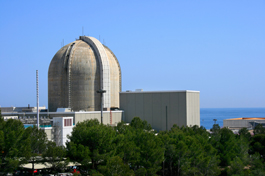
Source: Stock photography (copyrighted)
Did you know?
Nuclear reactors in the United States may have large concrete domes covering the reactors, which are required to contain accidental releases of radiation. Not all nuclear power plants have cooling towers. Some nuclear power plants use water from lakes, rivers, or the ocean for cooling.
Nuclear power comes from nuclear fission
Nuclear power plants heat water to produce steam. The steam is used to spin large turbines that generate electricity. Nuclear power plants use heat produced during nuclear fission to heat water.
In nuclear fission, atoms are split apart to form smaller atoms, releasing energy. Fission takes place inside the reactor of a nuclear power plant. At the center of the reactor is the core, which contains uranium fuel.
The uranium fuel is formed into ceramic pellets. Each ceramic pellet produces about the same amount of energy as 150 gallons of oil. These energy-rich pellets are stacked end-to-end in 12-foot metal fuel rods. A bundle of fuel rods, some with hundreds of rods, is called a fuel assembly. A reactor core contains many fuel assemblies.
The heat produced during nuclear fission in the reactor core is used to boil water into steam, which turns the blades of a steam turbine. As the turbine blades turn, they drive generators that make electricity. Nuclear plants cool the steam back into water in a separate structure at the power plant called a cooling tower, or they use water from ponds, rivers, or the ocean. The cooled water is then reused to produce steam.
Nuclear power plants generate about 20% of U.S. electricity
As of August 1, 2023, 93 nuclear reactors were operating at 54 nuclear power plants in 28 states. Of the 54 operating nuclear power plants, 19 have one reactor, 31 have two reactors, and 4 have three reactors. Learn more about the U.S. nuclear energy industry.
The United States generates more nuclear power than any other country
In 2021, 33 countries had commercial nuclear power plants, and in 15 of those countries, nuclear energy supplied at least 20% of their total annual electricity generation. The United States had the most nuclear electricity generation capacity and generated more nuclear electricity than any other country. France had the second-largest nuclear electricity generation capacity and third-highest nuclear electricity generation. In addition, France had the world's highest nuclear share—about 68%—of total national annual electricity generation.
Top five nuclear electricity generation countries in 2021
| Country | Nuclear electricity generation capacity (million kilowatts) | Nuclear electricity generation (billion kilowatthours) | Nuclear share of country's total electricity generation |
|---|---|---|---|
| United States | 95.49 | 778.15 | 19% |
| France | 61.37 | 360.70 | 68% |
| China | 53.26 | 407.52 | 5% |
| Russia | 27.73 | 222.44 | 20% |
| South Korea | 24.43 | 150.52 | 26% |
| Source: U.S. Energy Information Administration, International Energy Statistics, as of August 7, 2023 | |||
Types of nuclear reactors
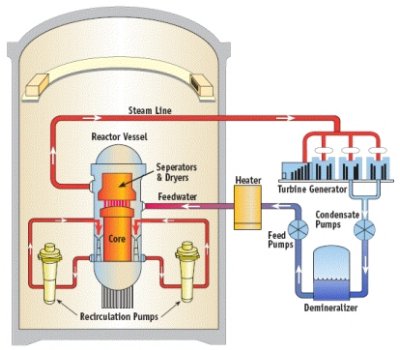
Source: U.S. Nuclear Regulatory Commission (public domain)
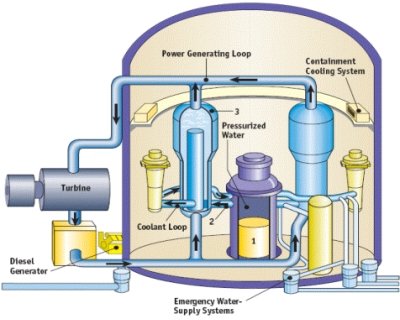
Source: U.S. Nuclear Regulatory Commission (public domain)
Nuclear reactors are machines that contain and control nuclear chain reactions while releasing heat at a controlled rate.
A nuclear power plant uses the heat that a nuclear reactor produces to turn water into steam, which then drives turbine generators that generate electricity.
U.S. nuclear power plants use two types of nuclear reactors
Nuclear power plants in the United States have either a boiling-water reactor or a pressurized-water reactor.
Boiling-water nuclear reactors
In a boiling-water reactor, the reactor core heats water, which turns directly into steam in the reactor vessel. The steam is used to power a turbine generator.
Pressurized-water nuclear reactors
In a pressurized-water reactor, the reactor core heats water and keeps it under pressure to prevent the water from turning into steam. This hot radioactive water flows through tubes in a steam generator.
A steam generator is a giant cylinder filled with nonradioactive water (or clean water). Inside the giant water-filled cylinder are thousands of tubes filled with the hot radioactive water from the reactor core that eventually bring the clean water to a boil and turn it into steam.
The radioactive water flows back to the reactor core to be reheated, and once reheated, returns to the steam generator. The clean water may come from one of several sources like oceans, lakes, or rivers.
What are small modular reactors?
The U.S. Department of Energy is supporting the design, certification, and commercialization of small modular reactors (SMRs). SMRs are about one-third the size of the reactors that are operating and under construction in the United States. SMRs have simple, compact designs that can be assembled in a factory and transported by train or truck to the power plant site. The size and simplicity of the SMRs could reduce the time it takes to construct a new nuclear power plant.
Getting (producing) uranium
The United States imports most of the uranium it uses as fuel
Uranium is the fuel most widely used by nuclear power plants for nuclear fission. Uranium is a common metal found in rocks all over the world. Uranium occurs in combination with small amounts of other elements. Economically recoverable uranium reserves are located in the western United States, Australia, Canada, Central Asia, Africa, and South America.
Owners and operators of U.S. nuclear power reactors purchased the equivalent of about 40.5 million pounds of uranium in 2022.
- Sources and shares of total U.S. purchases of uranium in 2022:
- Canada27%
- Kazakhstan25%
- Russia12%
- Australia9%
- Six other countries combined16%
Nuclear power & the environment
Did you know?
Nuclear reactors in the United States may have large concrete domes covering the reactor. A containment structure is required to contain accidental releases of radiation. Not all nuclear power plants have cooling towers. Some nuclear power plants use water from lakes, rivers, or the ocean for cooling.

Source: Stock photography (copyrighted)
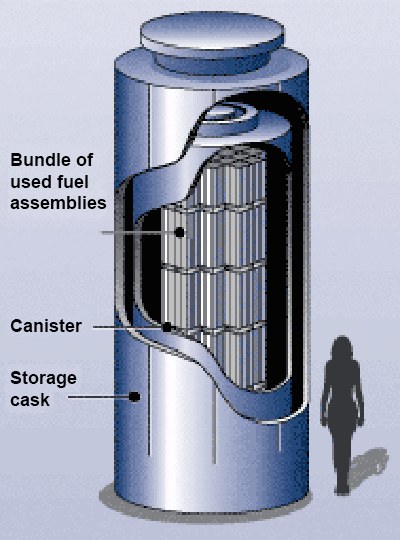
Some spent fuel storage canisters are designed to be placed vertically in robust above-ground concrete or steel structures.
Source: U.S. Nuclear Regulatory Commission (Public Domain)
Nuclear reactors and power plants have complex safety and security features
An uncontrolled nuclear reaction in a nuclear reactor could result in widespread contamination of air and water. The risk of this happening at nuclear power plants in the United States is small because of the diverse and redundant barriers and safety systems in place at nuclear power plants, the training and skills of the reactor operators, testing and maintenance activities, and the regulatory requirements and oversight of the U.S. Nuclear Regulatory Commission. A large area surrounding a nuclear power plant is restricted and guarded by armed security teams. U.S. reactors also have containment vessels that are designed to withstand extreme weather events and earthquakes.
Nuclear power reactors do not produce direct carbon dioxide emissions
Unlike fossil fuel-fired power plants, nuclear reactors do not produce air pollution or carbon dioxide while operating. However, the processes for mining and refining uranium ore and making reactor fuel all require large amounts of energy. Nuclear power plants also have large amounts of metal and concrete, which require large amounts of energy to manufacture. If fossil fuels are used for mining and refining uranium ore, or if fossil fuels are used when constructing the nuclear power plant, then the emissions from burning those fuels could be associated with the electricity that nuclear power plants generate.
Nuclear energy produces radioactive waste
A major environmental concern related to nuclear power is the creation of radioactive wastes such as uranium mill tailings, spent (used) reactor fuel, and other radioactive wastes. These materials can remain radioactive and dangerous to human health for thousands of years. Radioactive wastes are subject to special regulations that govern their handling, transportation, storage, and disposal to protect human health and the environment. The U.S. Nuclear Regulatory Commission (NRC) regulates the operation of nuclear power plants.
Radioactive wastes are classified as low-level waste or high-level waste. The radioactivity of these wastes can range from a little higher than natural background levels, such as for uranium mill tailings, to the much higher radioactivity of used (spent) reactor fuel and parts of nuclear reactors. The radioactivity of nuclear waste decreases over time through a process called radioactive decay. The amount of time it takes for the radioactivity of radioactive material to decrease to half its original level is called the radioactive half-life. Radioactive waste with a short half-life is often stored temporarily before disposal to reduce potential radiation doses to workers who handle and transport the waste. This storage system also reduces the radiation levels at disposal sites.
By volume, most of the waste related to the nuclear power industry has a relatively low level of radioactivity. Uranium mill tailings contain the radioactive element radium, which decays to produce the radioactive gas radon. Most uranium mill tailings are placed near the processing facility, or mill, where they come from. Uranium mill tailings are covered with a sealing barrier of material such as clay to prevent radon from escaping into the atmosphere. The sealing barrier is covered by a layer of soil, rocks, or other materials to prevent erosion of the sealing barrier.
The other types of low-level radioactive waste are the tools, protective clothing, wiping cloths, and other disposable items that become contaminated with small amounts of radioactive dust or particles at nuclear fuel processing facilities and nuclear power plants. These materials are subject to special regulations for their handling, storage, and disposal so they will not come in contact with the outside environment.
High-level radioactive waste consists of irradiated, or spent, nuclear reactor fuel (i.e., fuel that is no longer useful for producing electricity). The spent reactor fuel is in a solid form, consisting of small fuel pellets in long metal tubes called rods.
Spent reactor fuel storage and reactor decommissioning
Spent reactor fuel assemblies are highly radioactive and, initially, must be stored in specially designed pools of water. The water cools the fuel and acts as a radiation shield. Spent reactor fuel assemblies can also be stored in specially designed dry storage containers. An increasing number of reactor operators now store their older spent fuel in dry storage facilities using special outdoor concrete or steel containers with air cooling. The United States does not currently have a permanent disposal facility for high-level nuclear waste.
When a nuclear reactor stops operating, it must be decommissioned. Decommissioning involves safely removing from service the reactor and all equipment that has become radioactive and reducing radioactivity to a level that permits other uses of the property. The U.S. Nuclear Regulatory Commission has strict rules governing nuclear power plant decommissioning that involve cleanup of radioactively contaminated power plant systems and structures and removing the radioactive fuel.


